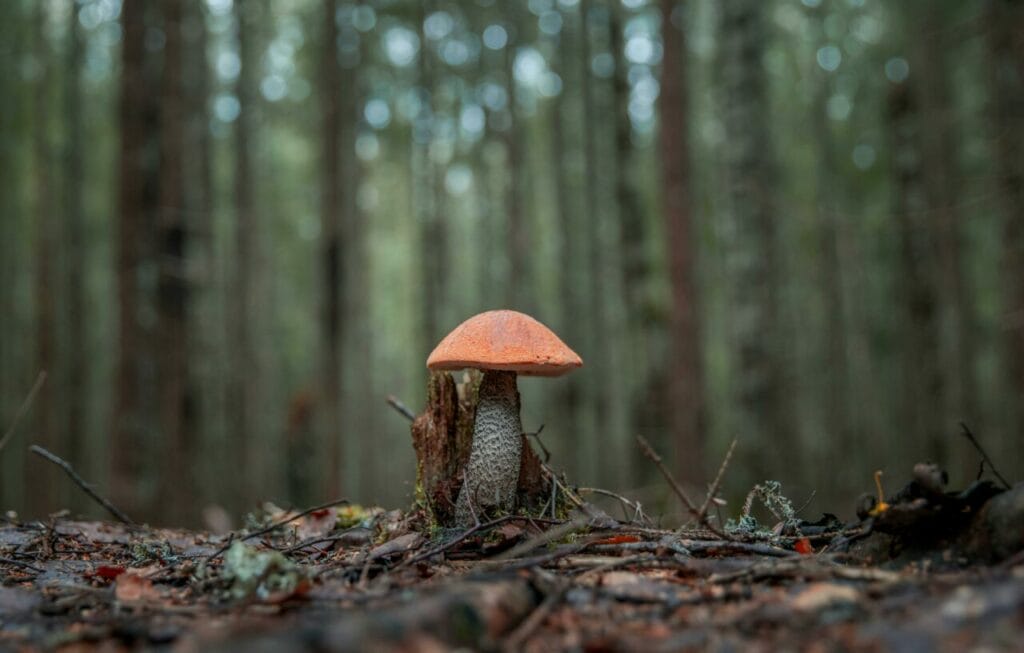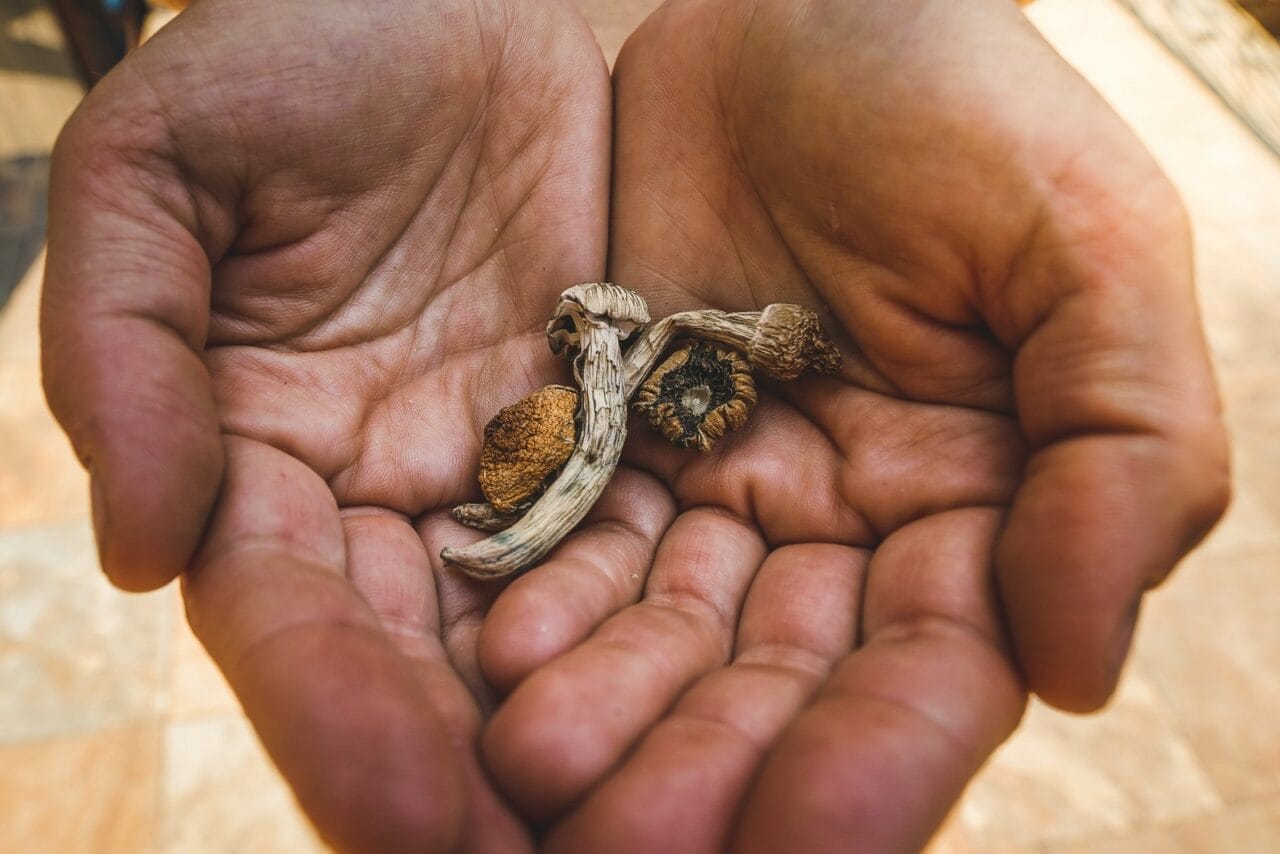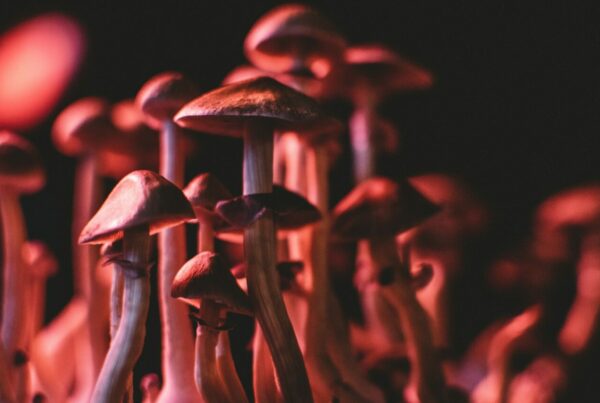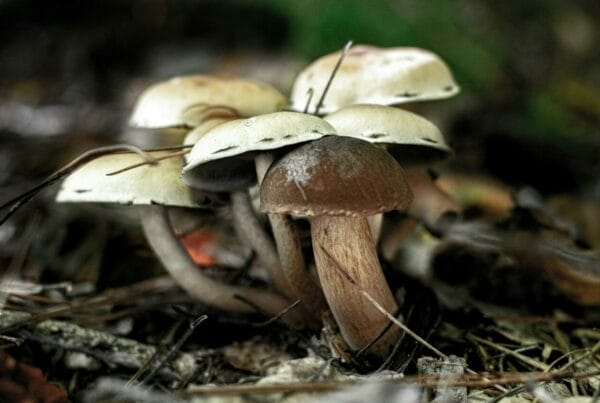If you’ve ever been curious about dried shrooms, you’re not alone. These intriguing substances are among the most sought-after psychedelics available today.
For beginners, deciding on the right psychedelic to try can be a daunting task. We’re here to demystify the world of dried mushrooms, highlighting how they differ from other psychedelics and why they could be an excellent choice for your inaugural psychedelic experience.
[toc]Main Takeaways:
- Psilocybe’s active compound is the most extensively studied psychedelic for mental health due to its safety, low risk of misuse, and brief duration of effects.
- Dehydrated Psilocybe is the most common form, ensuring potency and extending shelf life.
- Psilocybin activates the serotonin 5-HT2A receptor, leading to enhanced perception, vivid imagery, intricate hallucinations, and temporal distortions.

Psilocybin Mushrooms: An Exploration of the Psychedelic Mycology Realm
Psilocybin mushrooms contain the mind-altering compounds psilocybin and psilocin, responsible for the hallucinogenic experiences reported by users. The most recognized species, Psilocybe cubensis, is distinguished by a light brown cap, dark specks, and a unique form. Several other species within the Psilocybe genus also yield these compounds.
Some toxic mushrooms, containing harmful toxins, mimic the appearance of Psilocybe, which is why we caution against foraging for mushrooms on your own.
In the past, various mushrooms played a central role in spiritual rituals across Central America. Nowadays, their potential use in treating mental health disorders, including addiction, is being explored by researchers.
Processing and Storing: The Dried Variant
The most accessible form of Psilocybe is the dried variant. Dehydration is key for preserving its potency and extending its shelf life. Fresh mushrooms are usually dried using a food dehydrator or placed on a wire rack in a cool, dry area.
Ensuring the removal of excess moisture is crucial to prevent the growth of mold and bacteria.
Moisture could lead to the growth of mold, which can compromise the integrity of the active compounds in magic mushrooms. However, once these mushrooms are dried, they can be stored for future use.
Follow this comprehensive guide to effectively dry and store your magic mushrooms:
- First, thoroughly dry the mushrooms using a suitable food dehydrator or a wire rack.
- Store the dried mushrooms in airtight containers to preserve their potency and shield them from excessive moisture.
- Keep the containers in a dry, cool place to maintain the mushrooms’ psychoactive properties.
- Avoid exposing the mushrooms to direct sunlight to prevent degradation.
- Periodically examine the mushrooms for mold or dark spots as these are indications of spoilage.
How Psilocybe Cubensis Stacks Up Against Other Psychedelics
Beyond dried mushroom products, numerous other psychedelic substances are readily available online. These substances have diverse effects on the body and can be consumed in different manners. Many of these substances are categorized as classic hallucinogens, much like psilocybin.
| Substance | Origin | Physical Effects | Potential Therapeutic Uses | Duration of Effects |
| Psilocybin | Found naturally in over 200 mushroom species | Enhanced perception, hallucinations, distorted sense of time | Depression, Anxiety, PTSD, OCD, Cluster headaches, Alzheimer’s disease | 4-6 hours |
| DMT | Occurs naturally in plants like Psychotria viridis | Deep spiritual experiences, visions, auditory hallucinations | Depression, Addiction | 15-30 minutes |
| LSD | Synthetic, first synthesized by Albert Hofmann in 1938 | Intensified emotions, distorted perception, auditory and visual hallucinations | Depression, Anxiety, Addiction, Cluster headaches, Alzheimer’s disease, Tourette’s syndrome, ADHD | 8-12 hours |
| MDMA | Synthetic, first created by Anton Köllisch in 1912 | Increased release of serotonin, dopamine, norepinephrine, and possibly oxytocin | PTSD, Autism spectrum disorder, Obesity, Narcolepsy, ADHD | 3-6 hours |
| Ketamine | Synthetic, first created by Calvin L. Stevens in 1962 | Anesthetic, induces psychedelic effects at high subanesthetic doses | Depression, Bipolar disorder, Anxiety, Suicidal ideation, Addiction, Autism spectrum disorder, Chronic pain, Arthritis, Fibromyalgia | 1-3 effects |
How Does Your Body Respond to These Substances?
The operational mechanisms of each substance are hypothetical, based on observable outcomes. These hypotheses offer a glimpse into how these substances might exert their effects, but they don’t provide a conclusive understanding of the integral processes involved.
- Psilocybin: Eases the stimulation of the serotonin 5-HT2A receptor, leading to amplified perception, vibrant images, complex hallucinations, and distortions of time. It also triggers changes in thalamic gating and an increase in prefrontal cortex activity.
- DMT: Its interaction with serotonin receptors is just a portion of its overall effect, the full scope of which is yet to be determined. Despite the serotonin receptor being essential, it doesn’t fully account for all the effects of DMT.
- LSD: It functions within the serotonergic system in the Dorsal Raphe, binding to the 5-HT2A receptor as a partial agonist and the 5-HT1A receptor as a full agonist.
- MDMA: Instantly generates a sense of pleasure by promoting the release of dopamine and serotonin.
- Ketamine: Its exact mode of action is yet to be determined. Its antidepressant effect might stem from blocking NMDA receptors on neurons, although selective inhibition of NMDA receptors on GABAergic interneurons and suppression of AMPA receptors could also be factors.
What Impact Do Psychedelic Mushrooms Have?
The mental and physical reactions can vary significantly based on dosage, environment, and the individual’s psychological state. Common experiences associated with psychedelic mushrooms include:
- Visual and Auditory Hallucinations: Users may observe patterns, colors, and shapes that are not present in reality.
- Distorted Perception of Time: Time may appear to slow down or speed up.
- Altered Perception: Sensory experiences may be intensified or distorted.
- Emotional Variations: A wide range of emotions, from happiness to apprehension.
- Spiritual Insights: Experiences of a spiritual or mystical nature.
- Physical Effects: These may include an increased heartbeat and blood pressure, or feelings of sickness
When used responsibly, this substance is considered safe. However, without proper preparation, some users may have unpleasant experiences. Experienced users may find higher doses beneficial, but beginners who try to consume large amounts could have a “bad trip.”
Managing your experience with this substance is straightforward. Choose a calm, quiet environment and have a sober “trip guide” to help if needed.
A Preferable Option Compared to Other Substances
Medical practitioners often prefer dried shrooms due to their long shelf life and easy dosage. Their shorter duration and more manageable intensity make them an appropriate choice for those new to psychedelic therapy. They are also more natural than other synthetic hallucinogens, except for DMT.
Understanding the benefits of different compounds can be challenging, as many clinical trials show similar results, particularly between LSD and psilocybin. The latter is the most extensively researched psychedelic for mental health conditions, primarily due to its excellent safety record, low abuse risk, and short perceptual trips.
Health Benefits
- This natural compound may help reduce “cognitive rigidity,” lessen self-defeating thoughts, and promote self-compassion.
- A 2022 study discovered that a single 25 mg dose reduced depression scores in people with treatment-resistant depression. A 2023 study reported significant and long-lasting reductions in depressive symptoms with the combined use of regulated substances and psychotherapy.
- A 2022 clinical trial found that psilocybin-assisted psychotherapy significantly decreased the number of heavy drinking days over eight months compared to a placebo.
- A 2017 study published in the American Journal of Drug and Alcohol Abuse found that two to three doses, along with cognitive behavioural therapy (CBT), helped 10 out of 15 participants quit smoking for a year.
- In a 2022 pilot study published in Biological Psychiatry, four out of five patients with anorexia reported an improvement in their eating disorder symptoms after a single dose of shrooms with psychotherapy. Two of them also reported a reduction in anxiety.
- Studies on terminal cancer patients have revealed that the use of this compound, along with supportive measures, can help ease depression, anxiety, substance addiction, and fear of death. It also improves the quality of life and fosters a sense of optimism. The benefits were found to last for six months.
- In 80% of the participants, the benefits were sustained for several months.
Choose Your Favorite Dried Mushrooms to Embark on Your Journey
With the rise of easy-to-use online services, experiencing these products is simpler than ever. Place an order and have it delivered straight to your home.
| Features | Blue Meanies | Golden Teacher | Alacabenzi |
| Effects | Exhilaration, Hallucinations, Joy, Strong Laughter | Spiritual Revelation, Connection with Nature, Spiritual Restoration | Physical and Spatial Changes, Relaxation, Perception Alteration |
| Appearance | Brownish-yellow caps with blue marks | Broad light-colored caps, slender stems | Thick caps, reddish-brown stems |
| Potency | High | Medium | Medium |
| Recommended Use | Festivities, Parties, Artistic Inspiration | Spiritual, Shamanic Journey, Enlightenment | Relaxation, Evening Relaxation, Meditative State |
Choose Thoroughly Dried Magic Mushrooms for Their Established Effects and Benefits
Dried mushroom products offer a unique and powerful psychedelic experience, comparable to LSD, MDMA, DMT, and Mescaline. They are known for their introspective effects and possible therapeutic benefits. Being the most researched compound, it’s simpler to understand its advantages and learn how to use it effectively. Buy Shrooms Canada provides a variety of these fungi, ranging from the highly potent to strains suitable for beginners.
Frequently Asked Questions
Who should contemplate (or refrain from) psychedelic therapy?
If you’re dealing with depression, anorexia, alcohol addiction, trying to quit smoking, or confronting a terminal diagnosis, this therapy could be beneficial. However, if you or your family have a history of schizophrenia, psychosis, bipolar disorder, or borderline personality disorder, it’s essential to consult with your doctor before undertaking this therapy.
What should you expect from psilocybin therapy?
Psilocybin therapy, although intense, can provide lasting effects. The therapeutic process is typically divided into three main stages:
{“ordered”:true} –>- Preparation Phase: This initial stage encompasses one or more sessions, each lasting between 1-6 hours, with a facilitator. These sessions aim to address any concerns, clarify your objectives, and set a clear roadmap. The goal is to build trust and create a safe environment.
- Dosing Phase: This stage lasts for 5-8 hours. You will spend this time lying down, wearing an eye mask, and listening to a pre-selected playlist. A therapist will be with you throughout this entire experience.
- Integration Phase: This final stage includes post-session discussions designed to assist you in understanding and interpreting your experience. These sessions are distributed over several meetings, each of which lasts for a few hours.
Is buying shroom products more cost-effective than other substances?
When compared to LSD products, dried mushrooms are considerably more affordable. For example, you can buy 3.5 grams for about $20. Conversely, the cost of LSD in gel tabs varies depending on the dosage. For instance, six tabs at 100 micrograms each could potentially cost around $90.





